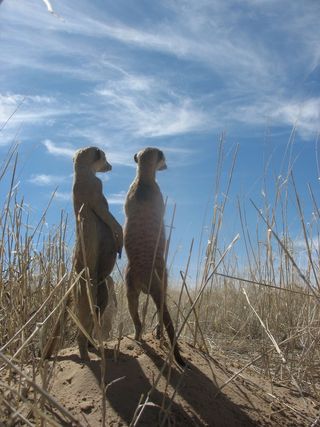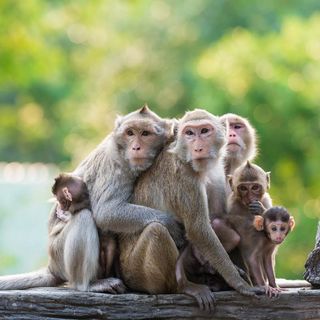Be Mine! Why Monogamy Evolved in Mammals

Male primates may have become monogamous to protect their offspring from being killed by rival males, a new study finds. However, others disagree, saying monogamy evolved in mammals so that males could guard their mates.
A team of British and Australian researchers compared data across 230 primate species over 75 million years, and found that the threat of infanticide — specifically, the threat of baby primates being killed by unrelated males — likely triggered monogamy.
Since infants are dependent on their mothers throughout childhood, and since female primates typically delay further conception while they are nurturing their young, male competitors may see advantages in doing away with babies that their rivals have sired, said study lead author Christopher Opie, a postdoctoral research fellow in the department of anthropology at the University College London in the United Kingdom. [8 Humanlike Behaviors of Primates]
"For a male who knows he's not the father of an infant, it can pay for him to kill that infant, because then he can make sure the female comes back into ovulation. And he can mate with her," Opie told LiveScience. "It's a way for males to try to increase their genes that are passed into the next generation."
The researchers examined the prevalence of infanticide across different primate species over time and found links between this threat and the onset of monogamy.
"When we looked across all 230 species, we saw that infanticide evolved at different points, but in all cases, it had already evolved by the time monogamy evolved," Opie said. The results were published online today (July 29) in the journal Proceedings of the National Academy of Sciences (PNAS).
Another study out today, however, suggests monogamy may have evolved to protect females against competition from other females.
Sign up for the Live Science daily newsletter now
Get the world’s most fascinating discoveries delivered straight to your inbox.
Neither study purports to explain monogamy in people. "We are cautious about making any definite statement about monogamy in humans," study researcher Tim Clutton-Brock of the University of Cambridge said in a press briefing, adding that when it comes to monogamy, "humans are obviously fantastically variable."
Primate family tree
Only 3 percent to 5 percent of all mammals bond for life, but researchers have long debated the evolution of monogamy, with scientists trying to pinpoint when in history animals displayed monogamous tendencies — and why.
To trace monogamy's evolutionary pathway, Opie and his colleagues constructed a giant family tree based on genetic data of the relationships among the species of primates. The researchers then used statistical models to identify where behavioral changes — such as the emergence of paternal care of offspring or the ranging patterns of females — likely occurred throughout the primates' evolutionary history.
"We effectively simulate evolution millions of times across the family tree and get probabilities for how each of the behaviors would change over time," Opie explained.
This technique resembles the one used by famed American statistician Nate Silver when he predicts the results of presidential elections, and the method used by Google when it produces search engine results, Opie said.
The models determined that male infanticide coincided with the switch from behavior in which females mated with multiple males, to monogamy in primates. The results also suggest that other behaviors, such as paternal care, resulted from monogamy. [The Animal Kingdom's Most Devoted Dads]
"In all the species where males provide care, monogamy already evolved in those species," Opie said. "So, we can see an evolutionary pathway where infanticide evolved first, then as one of the responses to that, monogamy evolved, and then in those species — but not all — paternal care evolved."
A far-reaching analysis?
While the study offers insight into the evolution of monogamy, the results are highly dependent on how the researchers classified the various species of primates, said Eduardo Fernandez-Duque, an associate professor of anthropology at the University of Pennsylvania in Philadelphia, who was not involved in the new study.
Fernandez-Duque, who has studied monogamy and paternal care in primates for 20 years, noted some inconsistencies in the descriptions of a few of the species, such as the classification that some primates in the genus Callicebus are sexually monogamous but not socially monogamous (they don't stay together to raise the offspring, for instance).
In addition, "the researchers treat infanticide as binary, which makes me a little uncomfortable," Fernandez-Duque told LiveScience. "For example, they categorize infanticide as high or low, but there's no room for species that don't show infanticide."
Still, Fernandez-Duque says the research represents exciting progress in the field of primatology, and he hopes to look deeper into the data.

Tracing the evolution of monogamy
Another study, this one detailed today in the journal Science, suggests monogamy evolved to allow males to protect females.
Using a new genetic classification technique, the researchers of the new study inferred how species were related and when they split off from one another in the evolutionary tree. The scientists classified each species as solitary (living alone), socially monogamous (living in breeding pairs) or as group-living. A total of 2,500 mammalian species were involved. [The Wild Kingdom: Take Our Animal Sex Quiz]
Then the scientists simulated how solitary females might evolve social monogamy versus how group-living females might evolve the trait. Researchers used sophisticated statistical methods to determine which scenarios were more likely.
Social monogamy evolved 61 times among the animals studied, the analysis showed. All but one of these transitions involved solitary females, rather than group-living females. In addition, the common ancestor of all mammals was solitary.
The findings suggest that for species in which females lived alone in large territories to avoid competition for food and other resources, males were unable to defend multiple females, and therefore became monogamous.
"In mammals, social monogamy is the result of resource distribution," study researcher Dieter Lukas, of the University of Cambridge, said in a press briefing today. Females were limited by the distribution of food, and males were limited by the distribution of females, Lukas said.
Social monogamy was also more common among primates and carnivores than other species, the study found. The more specialized diets of these animals may have increased competition for food, leading females to isolate themselves.
The findings failed to support the idea that the risk of infanticide led to monogamy in mammals, even in primates. The researchers suggest the discrepancy between the two studies could be explained by differences in how group-living is classified. For instance, some species that Opie's team classified as group-living were classified by Lukas as socially monogamous. Alternatively, the smaller sample of animals in Opie's study could have skewed their findings, Lukas and his colleagues said.
However, both studies found that parental care was more likely a consequence, not a cause, of the evolution of monogamy.
Follow Tanya Lewis on Twitter and Google+ & Denise Chow on Twitter @denisechow. Follow LiveScience @livescience, Facebook & Google+. Original article on LiveScience.com.

Denise Chow was the assistant managing editor at Live Science before moving to NBC News as a science reporter, where she focuses on general science and climate change. Before joining the Live Science team in 2013, she spent two years as a staff writer for Space.com, writing about rocket launches and covering NASA's final three space shuttle missions. A Canadian transplant, Denise has a bachelor's degree from the University of Toronto, and a master's degree in journalism from New York University.
Most Popular

